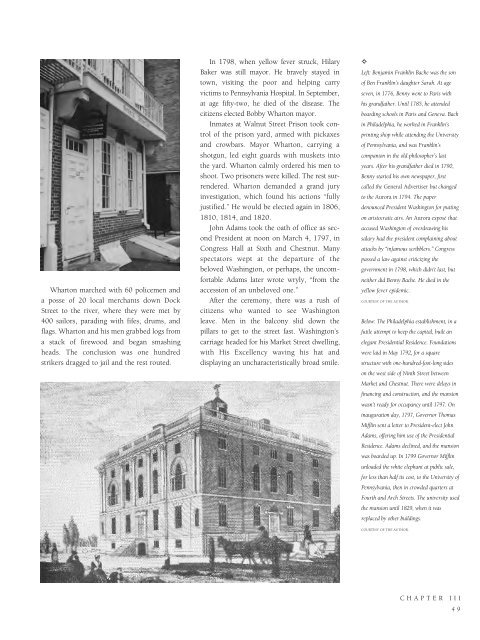Historic Philadelphia
An illustrated history of the city of Philadelphia, paired with the histories of companies, families and organizations that make the region great.
An illustrated history of the city of Philadelphia, paired with the histories of companies, families and organizations that make the region great.
You also want an ePaper? Increase the reach of your titles
YUMPU automatically turns print PDFs into web optimized ePapers that Google loves.
Wharton marched with 60 policemen and<br />
a posse of 20 local merchants down Dock<br />
Street to the river, where they were met by<br />
400 sailors, parading with fifes, drums, and<br />
flags. Wharton and his men grabbed logs from<br />
a stack of firewood and began smashing<br />
heads. The conclusion was one hundred<br />
strikers dragged to jail and the rest routed.<br />
In 1798, when yellow fever struck, Hilary<br />
Baker was still mayor. He bravely stayed in<br />
town, visiting the poor and helping carry<br />
victims to Pennsylvania Hospital. In September,<br />
at age fifty-two, he died of the disease. The<br />
citizens elected Bobby Wharton mayor.<br />
Inmates at Walnut Street Prison took control<br />
of the prison yard, armed with pickaxes<br />
and crowbars. Mayor Wharton, carrying a<br />
shotgun, led eight guards with muskets into<br />
the yard. Wharton calmly ordered his men to<br />
shoot. Two prisoners were killed. The rest surrendered.<br />
Wharton demanded a grand jury<br />
investigation, which found his actions “fully<br />
justified.” He would be elected again in 1806,<br />
1810, 1814, and 1820.<br />
John Adams took the oath of office as second<br />
President at noon on March 4, 1797, in<br />
Congress Hall at Sixth and Chestnut. Many<br />
spectators wept at the departure of the<br />
beloved Washington, or perhaps, the uncomfortable<br />
Adams later wrote wryly, “from the<br />
accession of an unbeloved one.”<br />
After the ceremony, there was a rush of<br />
citizens who wanted to see Washington<br />
leave. Men in the balcony slid down the<br />
pillars to get to the street fast. Washington’s<br />
carriage headed for his Market Street dwelling,<br />
with His Excellency waving his hat and<br />
displaying an uncharacteristically broad smile.<br />
✧<br />
Left: Benjamin Franklin Bache was the son<br />
of Ben Franklin’s daughter Sarah. At age<br />
seven, in 1776, Benny went to Paris with<br />
his grandfather. Until 1785, he attended<br />
boarding schools in Paris and Geneva. Back<br />
in <strong>Philadelphia</strong>, he worked in Franklin’s<br />
printing shop while attending the University<br />
of Pennsylvania, and was Franklin’s<br />
companion in the old philosopher’s last<br />
years. After his grandfather died in 1790,<br />
Benny started his own newspaper, first<br />
called the General Advertiser but changed<br />
to the Aurora in 1794. The paper<br />
denounced President Washington for putting<br />
on aristocratic airs. An Aurora exposé that<br />
accused Washington of overdrawing his<br />
salary had the president complaining about<br />
attacks by “infamous scribblers.” Congress<br />
passed a law against criticizing the<br />
government in 1798, which didn’t last, but<br />
neither did Benny Bache. He died in the<br />
yellow fever epidemic.<br />
COURTESY OF THE AUTHOR.<br />
Below: The <strong>Philadelphia</strong> establishment, in a<br />
futile attempt to keep the capital, built an<br />
elegant Presidential Residence. Foundations<br />
were laid in May 1792, for a square<br />
structure with one-hundred-foot-long sides<br />
on the west side of Ninth Street between<br />
Market and Chestnut. There were delays in<br />
financing and construction, and the mansion<br />
wasn’t ready for occupancy until 1797. On<br />
inauguration day, 1797, Governor Thomas<br />
Mifflin sent a letter to President-elect John<br />
Adams, offering him use of the Presidential<br />
Residence. Adams declined, and the mansion<br />
was boarded up. In 1799 Governor Mifflin<br />
unloaded the white elephant at public sale,<br />
for less than half its cost, to the University of<br />
Pennsylvania, then in crowded quarters at<br />
Fourth and Arch Streets. The university used<br />
the mansion until 1829, when it was<br />
replaced by other buildings.<br />
COURTESY OF THE AUTHOR.<br />
CHAPTER III<br />
49
















